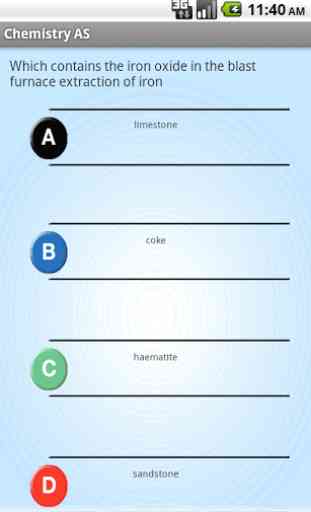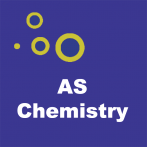Chemistry As
AS Chemistry; designed for exams from June 2014 onwards.
Questions are targeted for the AQA AS award 1421 and A level 2421 (Unit 1 and Unit 2), but is more that suitable for other specifications (please see the topic list below). Multiple modes target your learning, with explanations of correct answers (and Scheme of work reference).
Topic list
-
3.1.1 Atomic Structure Fundamental particles Protons, neutrons and electrons Mass number and isotopes Electron arrangement
3.1.2 Amount of Substance Relative atomic mass and relative molecular mass The mole and the Avogadro constant (L) The ideal gas equation Empirical and molecular formulae Balanced equations and associated calculations
3.1.3 BondingNature of ionic, covalent and metallic bonds Bond polarity Forces acting between molecules States of matter Shapes of simple molecules and ions
3.1.4 PeriodicityClassification of elements in s, p and d blocks Properties of the elements of Period 3 to illustrate periodic trends
3.1.5 Introduction to Organic ChemistryNomenclature Isomerism
3.1.6 AlkanesFractional distillation of crude oil Modification of alkanes by cracking Combustion of alkanes
Unit 2
3.2.1 Energetics Enthalpy change (DH) Calorimetry Simple applications of Hess’s Law Bond enthalpies
3.2.2 KineticsCollision theory Maxwell–Boltzmann distribution Effect of temperature on reaction rate Effect of concentration Catalysts
3.2.3 Equilibria The dynamic nature of equilibria Qualitative effects of changes of pressure, temperature and concentration on a system in equilibrium Importance of equilibria in industrial processes
3.2.4 Redox ReactionsOxidation and reduction Oxidation states Redox equations
3.2.5 Group 7(17), the HalogensTrends in physical properties Trends in the oxidising abilities of the halogens Trends in the reducing abilities of the halide ions Identification of halide ions using silver nitrate Uses of chlorine and chlorate(I)
3.2.6 Group 2, the Alkaline Earth MetalsTrends in physical properties Trends in chemical properties
3.2.7 Extraction of MetalsPrinciples of metal extraction Environmental aspects of metal extraction
3.2.8 HaloalkanesSynthesis of chloroalkanes Nucleophilic substitution Elimination
3.2.9 AlkenesAlkenes: structure, bonding and reactivity Addition reactions of alkenes Polymerisation of alkenes
3.2.10 AlcoholsNomenclature Ethanol production Classification and reactions Elimination
3.2.11 Analytical TechniquesMass spectrometry Infrared spectroscopy
Questions are targeted for the AQA AS award 1421 and A level 2421 (Unit 1 and Unit 2), but is more that suitable for other specifications (please see the topic list below). Multiple modes target your learning, with explanations of correct answers (and Scheme of work reference).
Topic list
-
3.1.1 Atomic Structure Fundamental particles Protons, neutrons and electrons Mass number and isotopes Electron arrangement
3.1.2 Amount of Substance Relative atomic mass and relative molecular mass The mole and the Avogadro constant (L) The ideal gas equation Empirical and molecular formulae Balanced equations and associated calculations
3.1.3 BondingNature of ionic, covalent and metallic bonds Bond polarity Forces acting between molecules States of matter Shapes of simple molecules and ions
3.1.4 PeriodicityClassification of elements in s, p and d blocks Properties of the elements of Period 3 to illustrate periodic trends
3.1.5 Introduction to Organic ChemistryNomenclature Isomerism
3.1.6 AlkanesFractional distillation of crude oil Modification of alkanes by cracking Combustion of alkanes
Unit 2
3.2.1 Energetics Enthalpy change (DH) Calorimetry Simple applications of Hess’s Law Bond enthalpies
3.2.2 KineticsCollision theory Maxwell–Boltzmann distribution Effect of temperature on reaction rate Effect of concentration Catalysts
3.2.3 Equilibria The dynamic nature of equilibria Qualitative effects of changes of pressure, temperature and concentration on a system in equilibrium Importance of equilibria in industrial processes
3.2.4 Redox ReactionsOxidation and reduction Oxidation states Redox equations
3.2.5 Group 7(17), the HalogensTrends in physical properties Trends in the oxidising abilities of the halogens Trends in the reducing abilities of the halide ions Identification of halide ions using silver nitrate Uses of chlorine and chlorate(I)
3.2.6 Group 2, the Alkaline Earth MetalsTrends in physical properties Trends in chemical properties
3.2.7 Extraction of MetalsPrinciples of metal extraction Environmental aspects of metal extraction
3.2.8 HaloalkanesSynthesis of chloroalkanes Nucleophilic substitution Elimination
3.2.9 AlkenesAlkenes: structure, bonding and reactivity Addition reactions of alkenes Polymerisation of alkenes
3.2.10 AlcoholsNomenclature Ethanol production Classification and reactions Elimination
3.2.11 Analytical TechniquesMass spectrometry Infrared spectroscopy
Category : Education

Related searches


